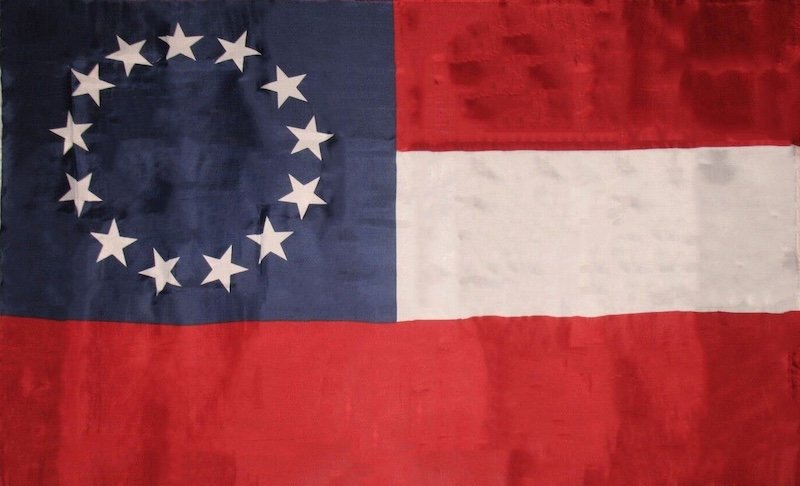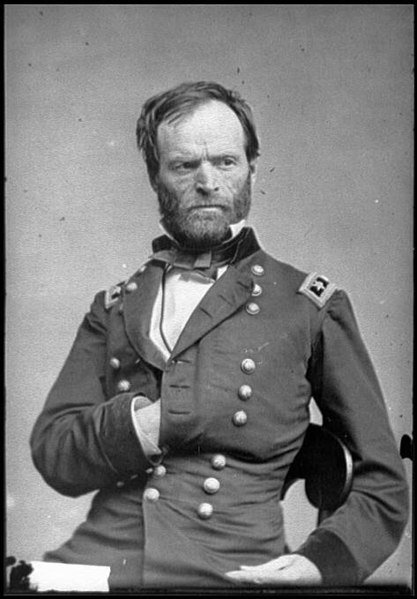Original flag of the Confederate States of America
When did the Civil War begin? This question can and should spark hours of conversation.
Since the creation of the United States, its political leaders orchestrated a delicate balance of admitting new states to the union as the country expanded westward. This balance was maintained by keeping the number of “free” and “slave” states equal as the country grew. The Kansas-Nebraska Act of 1854 discarded this practice and attempted to replace it with the mechanism of “popular sovereignty,” whereby the citizens of a territory would vote to decide if slavery would be prohibited. This compromise provoked fierce opposition on both sides and led to widespread voter fraud and political violence throughout the Kansas Territory. This saga of terrorism became known as “Bleeding Kansas.”
As the decade wore on both major political parties, the Whigs and the Democrats, split over the issue of slavery’s future in the West, leading to the creation of the Republican Party. Central to their agenda was prohibiting slavery’s expansion. While there was a small abolitionist fringe that advocated a complete elimination of slavery, the majority of the new party declared they had no intention of abolishing it where it already existed. However, pro-slavery politicians declared on many occasions that stopping the expansion of slavery ensured it would be eradicated where it already existed, and so was in fact, an attack on the southern states.
When the Republican Party ran Abraham Lincoln for the presidency in 1860, southern politicians began threatening secession immediately. After his victory, South Carolina seceded from the Union. Mississippi, Alabama, Georgia, Louisiana, Texas, and Florida soon followed. Between Lincoln’s election in November and his inauguration in March of 1861, all federal forts and armories in the seceded states were seized without a fight by Confederate forces, except Fort Sumter.
Once in office, Lincoln was immediately embroiled in managing the secession crisis. The Upper-South states, most critically Virginia, had not yet seceded and most Republicans still believed war could be averted. The official stance of the Republican Party was that secession was unconstitutional and illegal, thus they refused to recognize it officially. They claimed that what the Union faced was not a civil war, but a domestic insurrection. While this may seem like semantic nonsense, it all had real consequences about how the conflict would unfold. The Lincoln Administration worked to avoid war, but also, to prepare for it. In order to preserve the loyalty of the Upper-South, and the public generally, Lincoln believed it was critical that the North not be seen as firing the first shot. When he informed South Carolina officials that he intended to resupply the men of Fort Sumter with food and provisions, many believe he was maneuvering the Confederacy into striking first.
On April 12, 1861, as the supply ship approached, Confederate cannons opened fire on Fort Sumter. The attack lasted 34 hours and ended with the Confederate Flag flying over the fort. The only casualties of the battle occurred after the surrender. The Union troops were permitted to conduct a 100 gun salute before leaving. In the process, Private Daniel Hough’s gun malfunctioned and exploded in his hands, killing him and mortally wounding Private Edward Galloway.
Soon after the battle, 4 more southern states seceded: Virginia, Arkansas, Tennessee, and North Carolina. While most Americans, particularly in the border states were thrown into chaos, many hardliners on either side of the issue of slavery celebrated that the war had finally begun.
Sources:
Fort Sumter- National Parks Service
Flags of Ft. Sumter- National Parks Service
Fort Sumter Animated Map- American Battlefield Trust
Civil War Timeline- Library of Congress

